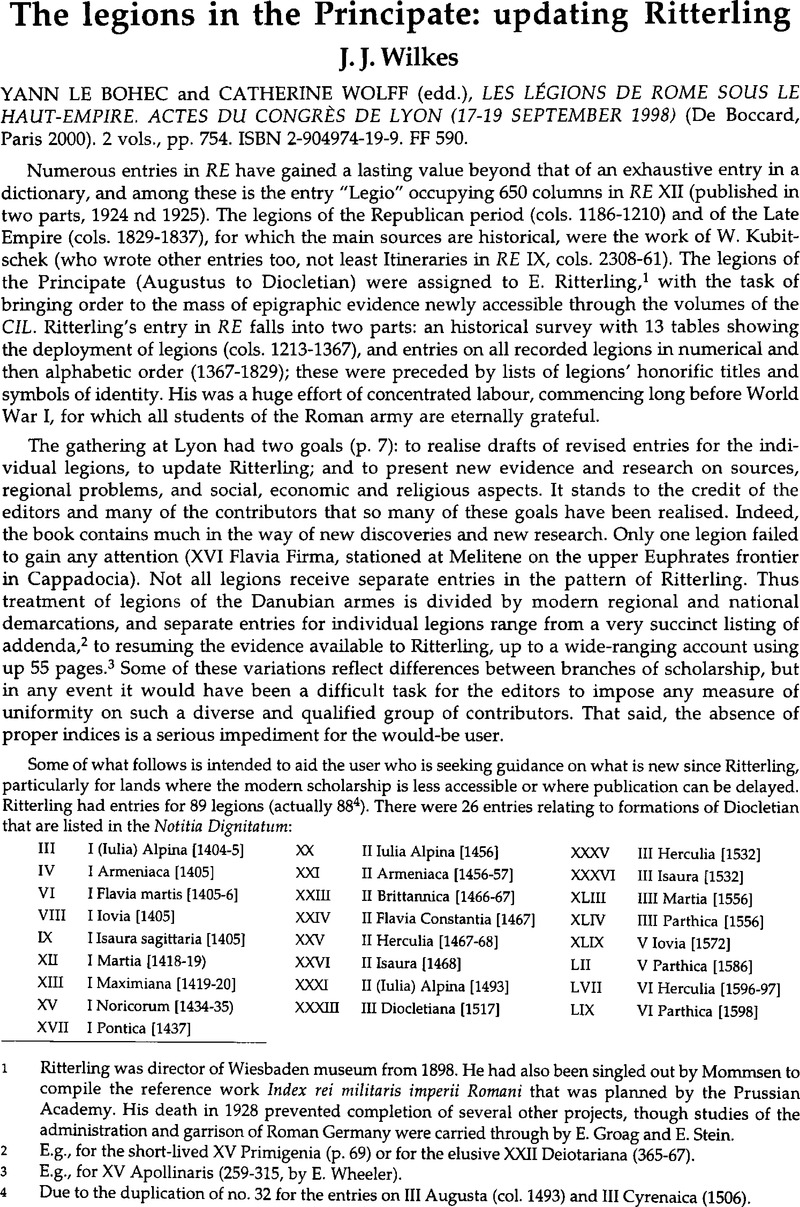Article contents
The legions in the Principate: updating Ritterling - Yann Le Bohec and Catherine Wolff (edd.), LES LÉGIONS DE ROME SOUS LE HAUT-EMPIRE. ACTES DU CONGRÈS DE LYON (17-19 SEPTEMBER 1998) (De Boccard, Paris 2000). 2 vols., pp. 754. ISBN 2-904974-19-9. FF 590.
Published online by Cambridge University Press: 16 February 2015
Abstract

- Type
- Reviews
- Information
- Copyright
- Copyright © Journal of Roman Archaeology L.L.C. 2002
References
1 Ritterling was director of Wiesbaden museum from 1898. He had also been singled out by Mommsen to compile the reference work Index rei militaris imperii Romani that was planned by the Prussian Academy. His death in 1928 prevented completion of several other projects, though studies of the administration and garrison of Roman Germany were carried through by E. Groag and E. Stein.
2 E.g., for the short-lived XV Primigenia (p. 69) or for the elusive XXII Deiotariana (365-67).
3 E.g., for XV Apollinaris (259-315, by E. Wheeler).
4 Due to the duplication of no. 32 for the entries on III Augusta (col. 1493) and III Cyrenaica (1506).
5 Keppie, L., The making of the Roman army (London 1984)Google Scholar, and in the first 10 chapters of his collected papers, Legions and veterans: Roman army papers 1971-2000 (Mavors 12, Stuttgart 2000), both fully indexed.
6 Keppie ibid. 1984, 205.
7 Keppie (supra n.5) 2000, 154 n.48.
8 Garcia Bellido 685-98.
9 Hallebos 465-68 and 482 fig. 2.
10 A suggestion by E. Hübner (CIL II 22*, 662, 719) that legion XX may have been in Spain can now be discarded since its colonists at Mérida are to be dated after A.D. 43 when the legion was stationed in Britain (S. Perea Yébenes 581-87).
11 Franke 39-48.
12 A. Morillo 623 fig. 4.
13 J. Gómez-Pantoja 169-90.
14 Ptol. 2.6.34; Itin. Ant. 423.3.
15 A. Morillo and V. García Marcos 589-607.
16 Wiegels 75-81.
17 For a guide to the evidence for Varus' three legions see Keppie (supra n.5) 2000, 161-65.
18 The title was evidently acquired during amalgamations following the battle of Actium: Franke 191-201.
19 Hallebos 466-67.
20 F. Bérard 49.
21 Laporte 557-79.
22 For those in the area of Narona, see E. Marin et al. 499-514.
23 Mitchell, S., Anatolia: land, men and gods in Asia Minor (Oxford 1993) vol. 1, 70 Google Scholar; Strobel 526-28.
24 Assuming that these are the same as the veterans of legion VII at Narona (Strobel 504).
25 Tac, Ann. 1.23 and 30.
26 M. Reddé 119-20; but Keppie (supra n.5) 2000, 91, notes that “it is not beyond the bounds of probability that both of these legions (V Macedonica and VIII Augusta) were in the East during Augustus' reign”.
27 Keppie ibid. 97-98.
28 Fellmann 127-31.
29 Keppie (supra n.5) 2000, 54.
30 Šašel-Kos, M., ZPE 109 (1995) 229 Google Scholar; cf. Wheeler 271.
31 2.112.
32 Keppie (supra n.5) 2000, 87.
33 M. A. Speidel 327-37.
34 As argued long ago by Gerov, B., ActaAntHung 15 (1967) 87–107 Google Scholar, reprinted in Beiträge zur Geschichte der römischen Provinzen Moesien und Thrakien (Amsterdam 1980) 147-67Google Scholar.
35 Strobel 525 n.75, citing Kabakìiieva, G. in Roman frontier studies: Proceedings of the int. congress 1999 (Zalau 2001) 487-94Google Scholar.
36 Dąbrowa 309-15 and n.4.
37 Cotton 353-57, citing a suggestion by Keppie that its early station may have been Raphanaea.
38 Dąbrowa 317-25 and n.2; Keppie (supra n.5) 1984, 132-34 and 208.
39 AE 1936.18; cf. Šašel-Kos, M., Inscriptiones latinae in Graecia repertae. Adăitamenta ad CIL III (Faenza 1979) 97 no. 230Google Scholar.
40 54.20.3; cf. Dąbrowa 318, n.l3.
41 Ann. 57.2.
42 Wolff 339-40.
43 Bertrandy and Rémy 253-57.
44 On this see now Keppie (supra n.5) 2000, 83-86.
45 CIL III 6097.
46 Daris 365-67.
47 Le Bohec 373-81.
48 Mann, C., Legionary recruitment and veteran settlement during the Principate (London 1983) 160 Table 44Google Scholar, tabulated legionary movements and stations for the years A.D. 50-150, and registered the disappearance of 8 legions in that period, of which half are shrouded in mystery.
49 Dio 54.20.4; Vellerns 2.97.1.
50 Suet., , Aug. 23.1 Google Scholar: Lolliana clades maioris infamiae quam detrimenti.
51 Schlüter, W., “The Battle of the Teutoberg Forest: archaeological research at Kalkreise near Osnabrück,” in Creighton, J. D. and Wilson, R. J. A., Roman Germany. Studies in cultural interaction (JRA Suppl. 32) 125-59Google Scholar.
52 Weigels 75 n.3, citing works by P. Kehne, R. Wolter, and F. Berger.
53 Cf. Birley, E., JRS 18 (1928) 56–60 Google Scholar, reprinted in his Roman army papers 1929-1986 (Amsterdam 1988) 311-15Google Scholar.
54 Tac., , Hist. 4.60 Google Scholar.
55 The numeral I was already more crowded.
56 CIL III 14214 = ILS 9107.
57 Jos., , BJ 7.4.3 Google Scholar; cf. Franke 43-44.
58 This reconstruction by Ritterling (cols. 1788-89) has been generally accepted.
59 Keppie 29.
60 Keppie (supra n.5) 2000, 247-55.
61 Daris 365.
62 This notion was supported by Keppie in a paper first published in 1990 (Keppie 2000, 225-32).
- 2
- Cited by




